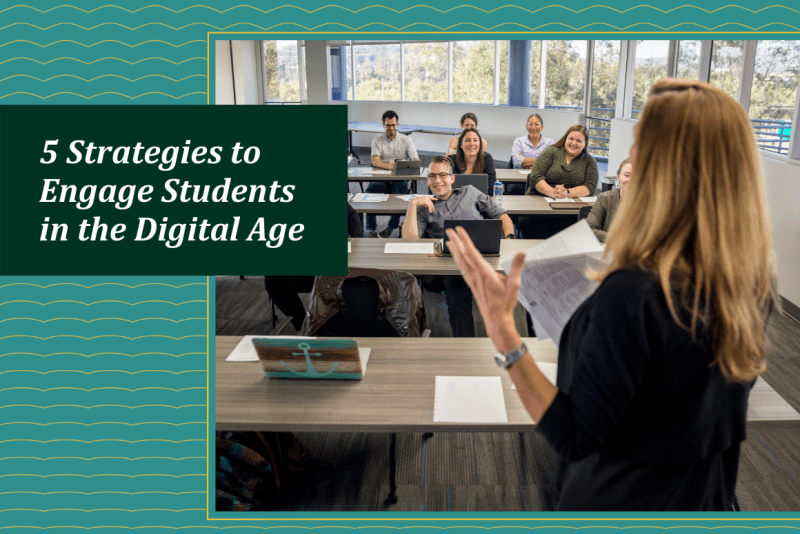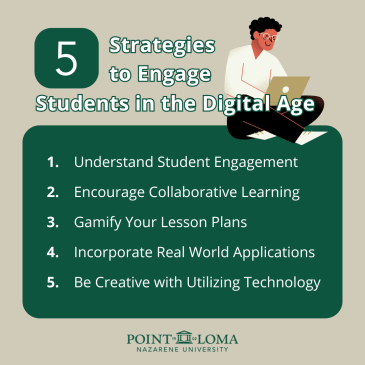
As a teacher, there’s no doubt that you’re constantly striving to develop a captivating and welcoming classroom for your students. However, you, along with the majority of teachers working today, have probably encountered some challenges in accomplishing this aim through digital learning environments.
Keeping students engaged in a physical classroom can be challenging enough. Conducting classes online through digital learning can make it even tougher to accomplish. From students feeling isolated from their peers to online curriculums sometimes feeling unclear, there are many hurdles that teachers must overcome to truly engage students in a virtual format.
Fortunately, committed teachers can cultivate compelling classrooms, whether online or in-person, that captivate students by implementing the right student engagement strategies and utilizing the right classroom technology. Any teacher intent on thriving in the digital age can benefit from a familiarity with these key educational concepts.
Here are 5 effective strategies to engage students in the digital age:
1. Understand student engagement
If you want to truly engage in meaningful practices that help students feel more engaged, it’s vital to understand student engagement yourself as a teacher. According to McREL International, a non-profit organization committed to improving educational outcomes for all students, student engagement is a broad concept with an ever-evolving meaning. At its inception, this term was meant to refer to the amount of physical and psychological energy that students directed toward academic pursuits.
As educational philosophies, classroom technology, and applied practices have evolved over the decades, so has the definition of student engagement. Today, student engagement also refers to the motivation students feel to deeply comprehend academic materials. In other words, how driven students are to apply themselves to learning concepts for the sake of learning itself rather than being purely motivated by earning good grades.
As a teacher, your goal should be to not only encourage students to thrive in their grades, but to feel a greater desire to simply learn new things. Getting students in the habit of getting joy out of encountering new ideas will help set them up for success in the future.
2. Encourage collaborative learning
Over the years, collaborative learning has emerged as an effective tool for teachers to excite their students about lessons and cultivate deeper comprehension of topics. In an age where technology has become a ubiquitous force in virtually every facet of society — including education — getting students to collaborate digitally needs to be a top priority for teachers.
Essentially, collaborative learning is an educational practice that encourages students to work together to learn specific concepts or solve particular problems. Through this practice, students can ask each other questions, explain the concepts they are learning, and discuss new ideas. Some key examples of this meaningful practice include breaking students off into discussion groups, peer-editing groups, and project groups. This can look like break-out video calls, message boards, or other messaging tools. Just be sure to heavily monitor and screen the tools and activities that are at play to make sure that each student is safe, secure, and happy.

When it comes to boosting student engagement in online learning scenarios and virtual classrooms, collaborative learning allows students to meaningfully interact with each other and, as a result, feel more open to truly comprehending the topics they’re learning about. It can also help students make friends, build their digital literacy, and lead them to enjoy education in general.
3. Gamify your lesson plans
No matter what type of classroom you find yourself teaching in — whether it’s in-person, remote, or a combination of the two — gamifying your lesson plans can radically boost student participation. This strategy is especially useful for teachers transitioning into digital classrooms after only having work experience as an educator in in-person classrooms.
Gamifying a lesson is simply the act of adding game-related components to a lesson. For example, rather than giving students a quiz after a lecture, you can allow students to play a digital trivia game on the subject.
These acts of blending technology and education encourage students to use their creativity and compete with each other, thereby making them feel more invested and engaged in lessons. It can also really meet students in their element, adding a touch of familiarity and fun. It really can be the difference for some students to feel an excitement for learning.
4. Incorporate real-world applications
One key reason that students don’t feel compelled to apply themselves to lessons is that they don’t always feel as if what they’re learning will apply to their lives. If many students in your class feel this way about particular lessons, student engagement is sure to drop significantly.
To circumvent this problem and ensure that your students are engaged regardless of the subject, it’s crucial to incorporate real-world applications into lessons.
In essence, this strategy involves showing your
students real-world examples of how lessons are being applied. For example, instead of providing clear-cut answers to problems, try to recreate problems that people would experience in the real world.
This can include asking students what they would do if they were environmental scientists trying to save an endangered species of animal, or how they would respond to a cut in funding as a public health researcher. Or, in each class you can highlight how a topic they’re learning about can relate to career skills down the line.
Ultimately, these lessons will help students understand the direct connection between what they’re learning and their potential personal and professional lives. As a result, they’ll feel more motivated to apply themselves in the classroom and truly engage with the learning materials you provide them.
5. Be creative with utilizing technology
If you’re teaching remote students through digital media, you’re already aware of the profound impact that the intersection of technology and education is having on modern students. However, if you’re teaching students in in-person classrooms, it may be a good idea to make digital learning a priority in your lesson plans.
Most students in the modern age are digitally literate and enjoy using digital technology for a variety of processes. Incorporating digital technology in the classroom can make these students feel more comfortable, interested, and engaged.
As a teacher, there are a wide variety of ways that you can introduce digital learning and classroom technology into your lesson plans. From using laptops or tablets in class to using YouTube videos to bolster learning to making lessons more interactive, utilizing technology in the right ways can excite your students and improve their learning outcomes. Research what kind of ways students are interacting with current and emerging technologies, and think about where your lesson content could be presented in nontraditional ways.
______
Who are you called to be?
Pursue your purpose at PLNU.
______
Hone your teaching skills in the digital age
Just because you’ve added more student engagement strategies to your educational toolbelt doesn’t mean that you should stop there.
Whether you’re a veteran teacher interested in furthering your efficacy in the classroom or a new teacher with ambitions to have an impactful teaching career, furthering your education can help you accomplish your career goals.
PLNU’s Master of Arts in Teaching program provides you with all of the tools and support you need to establish your credibility as an educator and network with other top professionals in your field.
To learn more about the Teaching M.A., explore PLNU’s celebrated teaching programs to see how you can start transforming your educational career today.